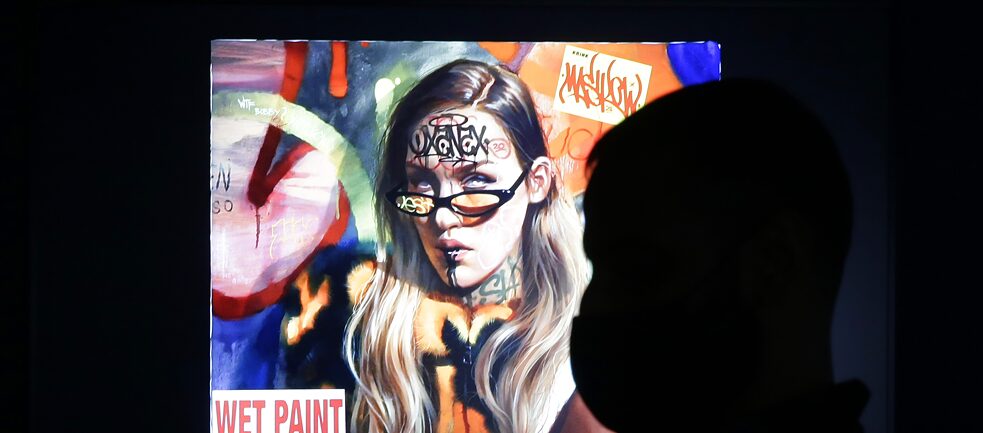Non-fungible tokens
A revolution in the digital art market

A blockchain technology is making waves in the art scene. For the first time, non-fungible tokens (NFTs) are making it possible to trade digital art just like paintings, sculptures or photographs – and charge equally high prices. We look at what non-fungible tokens are all about and how they can bring in so much money.
By Stefan Kobel
The technical name of a blockchain element – NFT or non-fungible token – is currently the unexpected number one topic of conversation in the art market. This technology is the first to make it possible to distinguish between an original and a copy, even for digital works of art, opening up a whole new market.
Ever since Christie’s New York auction house sold Beeple’s, aka Mike Winkelmann, Everydays: The first 5000 days for 69 million US dollars, NFTs have been the talk of the town. The truly astonishing part is that this enormous sum was paid for a digital work of art that could, in principle, be reproduced at will. Any internet user could download a copy, even if the resolution might be less than satisfactory. The only difference between the “original” and the “copy” is the linked token that makes the original piece forgery-proof and thus unique (see info box).
Initially, this is a great advantage for artists. To date, trading digital art like paintings, sculptures or other formats has been difficult because there is no physical object associated with a digital piece, so there is also no original. Another complication is that there can be endless number of identical copies of the same work. With the help of NFTs, artists can now release as many pieces of their digital work as they want – as unique, limited, or open editions. They can even decide if they want a percentage of the resale of their work. This is a huge step forward from conventional practice, where artists often do not benefit at all as the value of their work increases, or there heirs do at some point via modest resale rights income.
 “How much is the fisch?” Together with Scooter, H.P. Baxxter was one of the first musicians to certify special editions of his new album using NFTs.
| Photo (detail): © picture alliance/dpa/dpa-Zentralbild/Jens Kalaene
“How much is the fisch?” Together with Scooter, H.P. Baxxter was one of the first musicians to certify special editions of his new album using NFTs.
| Photo (detail): © picture alliance/dpa/dpa-Zentralbild/Jens Kalaene
Just a speculative bubble?
However, the current boom could very quickly turn out to be a speculative bubble. The relevant platforms are still dominated by digital banalities, at least volume-wise, while the traditional art scene seems to be gaining a foothold quite slowly.
There is also a widespread misconception that NFTs generally take the form of a work of art. An NFT can basically be anything though – a CryptoPunk consisting of a few pixels, a huge digital collage like Beeple’s, an animated computer graphic like those made by musician Grimes, a sneaker design, a collectable NBA basketball-league trading card, or the digital art that is already part of the traditional art world with its museums, art associations, galleries, and fairs.
Whether the buyers, who each paid 140,000 euros for one of nine copies of one of the numerous digitized masterpieces from the Florentine Uffizi, will ultimately leave their heirs a tidy nest egg remains to be seen. As does whether the fund which Beeple’s digital collage is part of will ever yield a return, or whether anyone in 100 years’ time will still be interested in who owns the “original” Nyan Cat. We can safely view these as marginal phenomena of the art market. What is primarily driving the boom in NFTs is a capital market that has found a welcome speculative instrument in cryptocurrencies. There is still a lot of tweaking to be done, but ultimately time and the market will probably work out the bugs.
What are NFTs?
Non-fungible token (NFT for short) is a term from the world of blockchain and cryptocurrencies. A blockchain consists of closed data records that are strung together like links in a chain. Attempting to manipulate or change any of these blocks would break the chain. This is why blockchains are generally regarded as secure against attempts at forgery and hacking – which makes them so interesting for use as a means of payment, for example.
The virtual means of payment stored in a decentralised system in the blockchain are interchangeable units – so-called fungible tokens: In principle, one Bitcoin or Ether is the same as any other, as they each have the same asset value. Non-fungible tokens are different. Here the decisive component is not the trading value of the respective coin; it is that each unit or token in the decentralized blockchain is uniquely identifiable by a unique hash code, making it forgery-proof; every other unit behind it in the chain “knows” about it.
This property can be used for verification in many areas – from electronic land registers to vaccination passports. Since around 2015, insurance companies in particular have been looking for a way to use these tokens to add an electronic watermark to works of art, making them identifiable and traceable. This would deprive counterfeiters and fraudsters of the basis for their activities. The technical side is the tricky bit: How can a file be physically connected to an object in such a way that it is indestructible and cannot be removed without authorisation, but does not impact the object itself?
Resourceful minds have found a simple solution: Just omit the physical artwork and replace it with a digital one – a JPEG, for example. The result is precisely the phenomenon that is currently causing a furore in the art world: NFTs – non-fungible tokens. So NFTs are first and foremost simply a method of adding a signature to files – including digital artworks – thus making them unique.
Comments
Comment